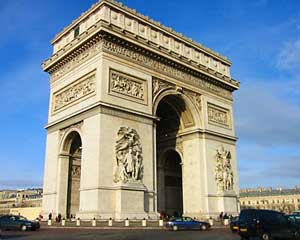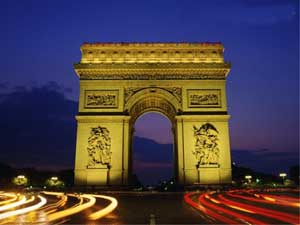The Arc de Triomphe stands majestically at the center of its own star, in the closet thing that secular France has to sacred ground.
Associated with two of the country’s greatest men, the history of the monument evokes both joyful and dark historical memories.
The first great man, Napoleon, ordered the construction of Arc de Triomphe as a celebration of his military successes in 1809.
Napoléon liked to think of himself as the Roman emperors' heir so he had the arch modeled on Rome's Arch of Titus.

Unfortunately, the French emperor was not as strong architecturally as he was strategically and the Arc de Triomphe turned into a slight embarrassment. The idea was that the monument had to be completed in time for the parade in honor of Napoleon's new bride but in fact in 1810 the arch was still only a few feet high, and a painted arch had to be thrown up to hide the shame.
By the time the Arc de Triomphe was finally finished, in 1836, Napoleon's empire was long gone.
He never lived to see it finished, but we're sure he would have been proud to see the Arc decorated with a frieze of battle scenes including Rude's famous Le Départ des Volontaires (aka La Marseillaise).
Napoléon's generals are remembered in the inscriptions on the stone facades.
Charles de Gaulle is the second great Frenchman associated with Arc de Triomphe. On August 26, 1944 he relit the eternal flame that burns there after a legendary triumphant march through Paris.
His words are remembered in a bronze plaque: Quoi qu'il arrive, la flamme de la résistance française ne doit pas s'éteindre et ne s'éteindra pas. (Whatever happens, the flame of the French resistance must not be extinguished and will not be extinguished).
Given its vital role in Paris’ history, it is no surprise that the Arc de Triomphe attracts many visitors each year. The Tomb of the Unknown Soldier, illuminated by an eternal flame (that de Gaulle relit), is situated under the arch, and was added to the structure on November 11, 1920.
The memorial honors the 1.5 million Frenchmen who died during WW1. The flame is rekindled every evening at 6:30, which is the most atmospheric time to visit.
It is well worth the 40-step climb which rewards you with stunning views of the Champs Elysées and the Louvre and there is also the impressive new museum to explore as well.

The museum, opened in 2008, houses a permanent exhibition that charts the tumultuous history of the Arc de Triomphe as well as other famous arches throughout Europe.
Once you climb the stairs and reach the top of the Arc it is possible to see the twelve avenues that begin in the square, and the impressive sight that presents Champs-Élysées followed by Place de la Concorde and further away the Louvre Museum.
Quick hint: do not try to get into the Arc de Triomphe by crossing the death-swirl of traffic at its base - it will not be a happy experience. There is an underground passageway that surfaces on the even-numbered side of Avenue des Champs Élysées. Tickets are sold in this pedestrian underpass before going up to the ground level.
Sadly for Napoleon, the Parisian Arc de Triomphe is actually the second largest triumphal arch in the world. In 1982, in a fit of childish competition, the Koreans built there own arch at the foot of Moran Hill in the North Korean capital city of Pyongyang.
Their arch, which honors President Kim Il-sung's role in the resistance against Japanese rule, was modeled on its Parisian counterpart but deliberately built to be slightly larger.
Coming in at 60 meters (197 ft) high and 50 m (164 ft) wide, it trumps the French effort by 10 meters in height and 5m in width.